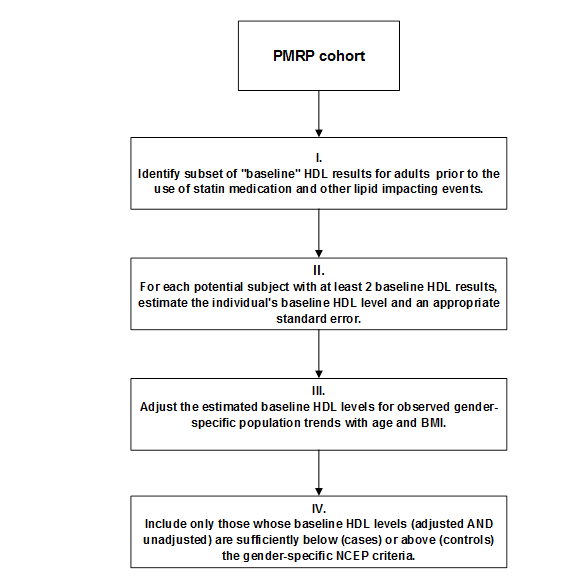eMERGE
High-Density Lipoproteins (HDL)
Algorithm to identify patients with low levels of high-density lipoproteins (HDL).
FLOWCHART of HDL Phenotyping Process

Hypothyroidism
Project Outline: Selection of all Caucasian patients with hypothyroidism without a secondary cause of surgical removal or radiological ablation. The search is designed to eliminate subclinical hypothyroidism (by requiring that patients be on a replacement medication), medication-induced hypothyroidism (e.g., PTU, lithium, or history of amiodarone), and transient causes (e.g., pregnancy or subacute thyroiditis).
Intellectual Disability
Lipids
Migraine
Migraine is the most common recurrent headache syndrome in children in which 4-10% of school age children may be affected (1). It is characterized by episodes of headache pain that may be accompanied by nausea, vomiting, and light and sound sensitivity. Migraine occurs at all ages and may even begin in infancy as represented by intermittent colic (1). The genes for familial hemiplegic migraine have been identified.
Ovarian/Uterine Cancer (OvUtCa)
The KPWA/UW-led ovarian/uterine cancer phenotype has been validated at Mayo Clinic, the secondary phenotype development site. Validation results at both the primary and secondary sites were strong and the phenotype is ready for network wide implementation. The pseudo code document posted 11/30/2017 is correct as is and should be used by network sites for phenotype implementation. A validated data dictionary of covariates for this phenotype will be added to PheKB by 2/15/2018, but sites are encouraged to begin implementing the phenotype algorithm now.
Peanut Allergy
Food allergy is defined as an immune response that occurs reproducibly to a given food, typically an immunoglobulin E (IgE)-mediated clinical reaction to specific protein epitopes. Over the last 20-30 years, food allergy has grown into a major public health problem. Peanut allergy is a common type of food allergy that accounts for a disproportionate number of fatal and near-fatal anaphylactic events amongst all the common food allergens.
Peripheral Arterial Disease - 2012
Peripheral Arterial Disease (PAD) is prevalent with approximately 10-12 million adults in US affected. For those with PAD, morbidity and mortality are high and quality of life is markedly impaired. The genetic basis of PAD is poorly understood and is the focus of the Mayo Clinic Electronic Medical Records and Genomics (eMERGE) Network study.
PGx medication risk prediction model
This algorithm predicts those who are going to be exposed to warfarin, simvastatin, or clopidogrel as three medications that have known pharmacogenomic influences. This algorithm was used to select individuals for the Vanderbilt PREDICT (Pharmacogenomic Resource for Enhanced Decisions in Care & Treatment) program, which prospectively tests individuals at risk of needing medications whose efficacy is effected by genetic variants.
For more information on PREDICT, see http://mydruggenome.org.
